Introduction to Management: Structure, Functions, and HR Report
VerifiedAdded on 2022/12/29
|9
|1990
|32
Report
AI Summary
This report provides an introduction to management, exploring organizational structure and business functions. It delves into the scientific and bureaucratic theories of management, outlining their principles and providing examples of divisional and matrix structures. The report then examines key business functions such as human resources, marketing, and finance, detailing their roles and responsibilities. It further analyzes the marketing function, including brand promotion, marketing research, and SEO. The report also discusses Henry Fayol's five functions of management – planning, organizing, commanding, coordinating, and controlling – along with the roles and responsibilities of HR and talent management, providing real-world examples from companies like Tesco and Asda. Finally, it explores organizational culture, its types, and its impact on organizational performance, offering a comprehensive overview of management principles and practices.
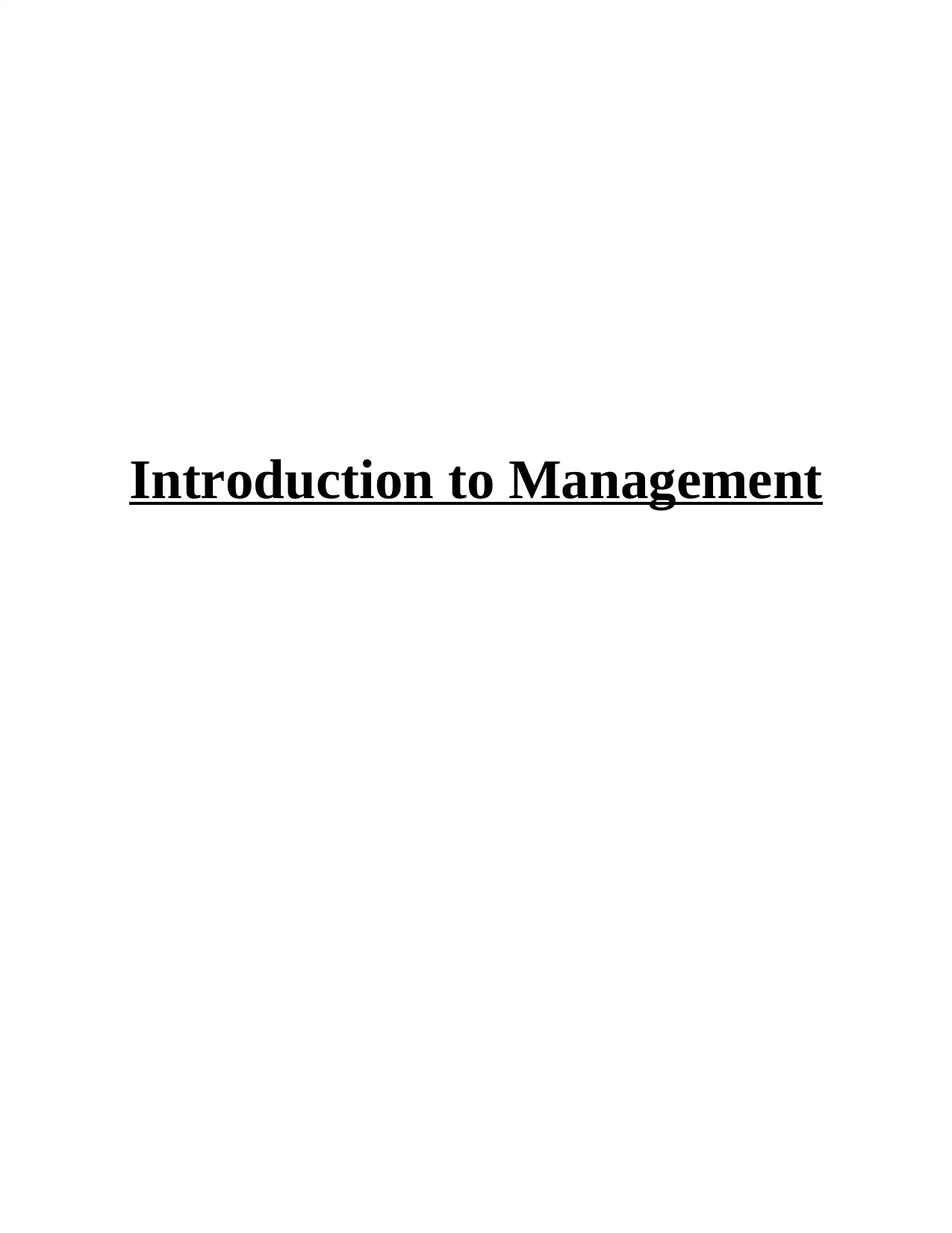
Introduction to Management
Paraphrase This Document
Need a fresh take? Get an instant paraphrase of this document with our AI Paraphraser
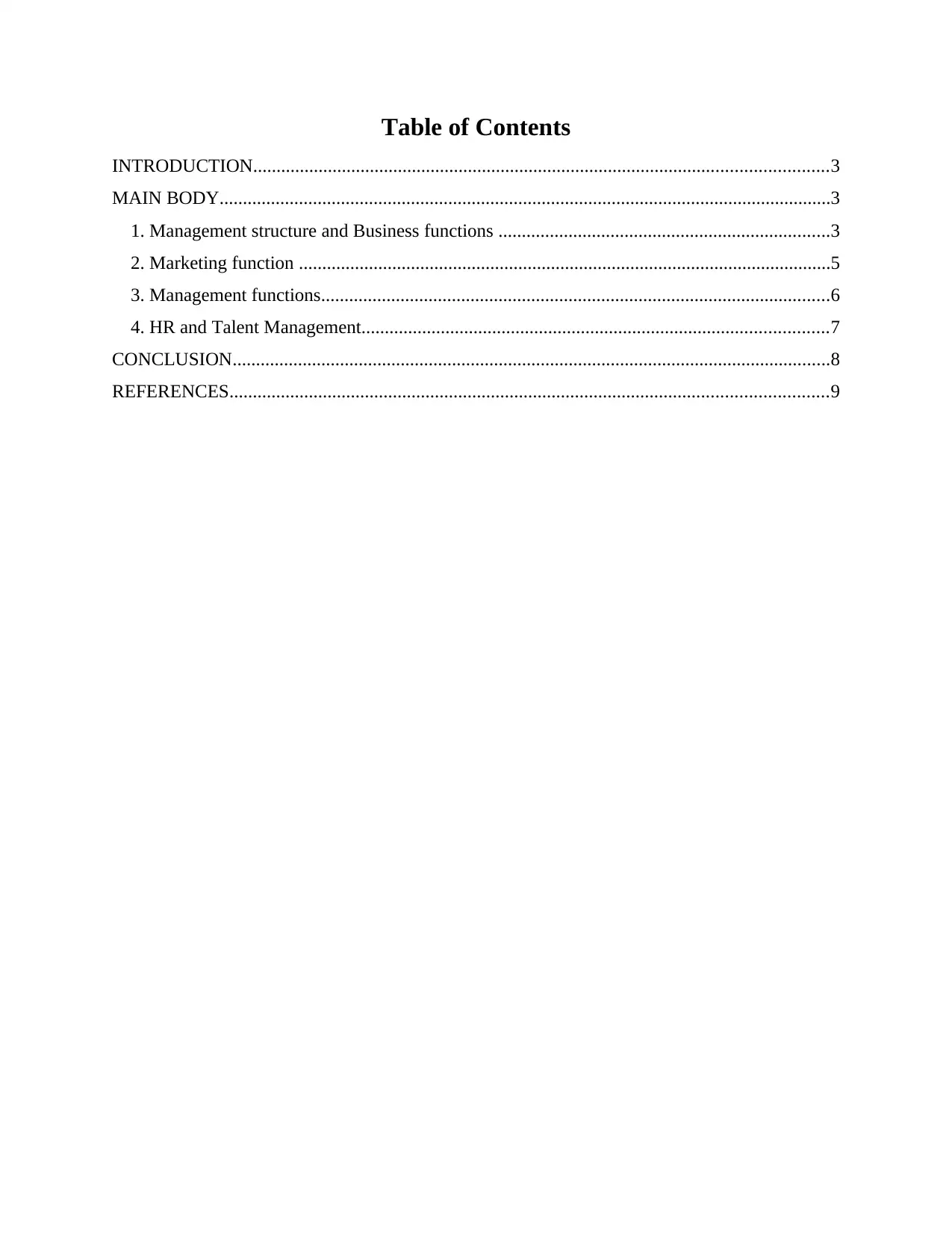
Table of Contents
INTRODUCTION...........................................................................................................................3
MAIN BODY...................................................................................................................................3
1. Management structure and Business functions .......................................................................3
2. Marketing function ..................................................................................................................5
3. Management functions.............................................................................................................6
4. HR and Talent Management....................................................................................................7
CONCLUSION................................................................................................................................8
REFERENCES................................................................................................................................9
INTRODUCTION...........................................................................................................................3
MAIN BODY...................................................................................................................................3
1. Management structure and Business functions .......................................................................3
2. Marketing function ..................................................................................................................5
3. Management functions.............................................................................................................6
4. HR and Talent Management....................................................................................................7
CONCLUSION................................................................................................................................8
REFERENCES................................................................................................................................9
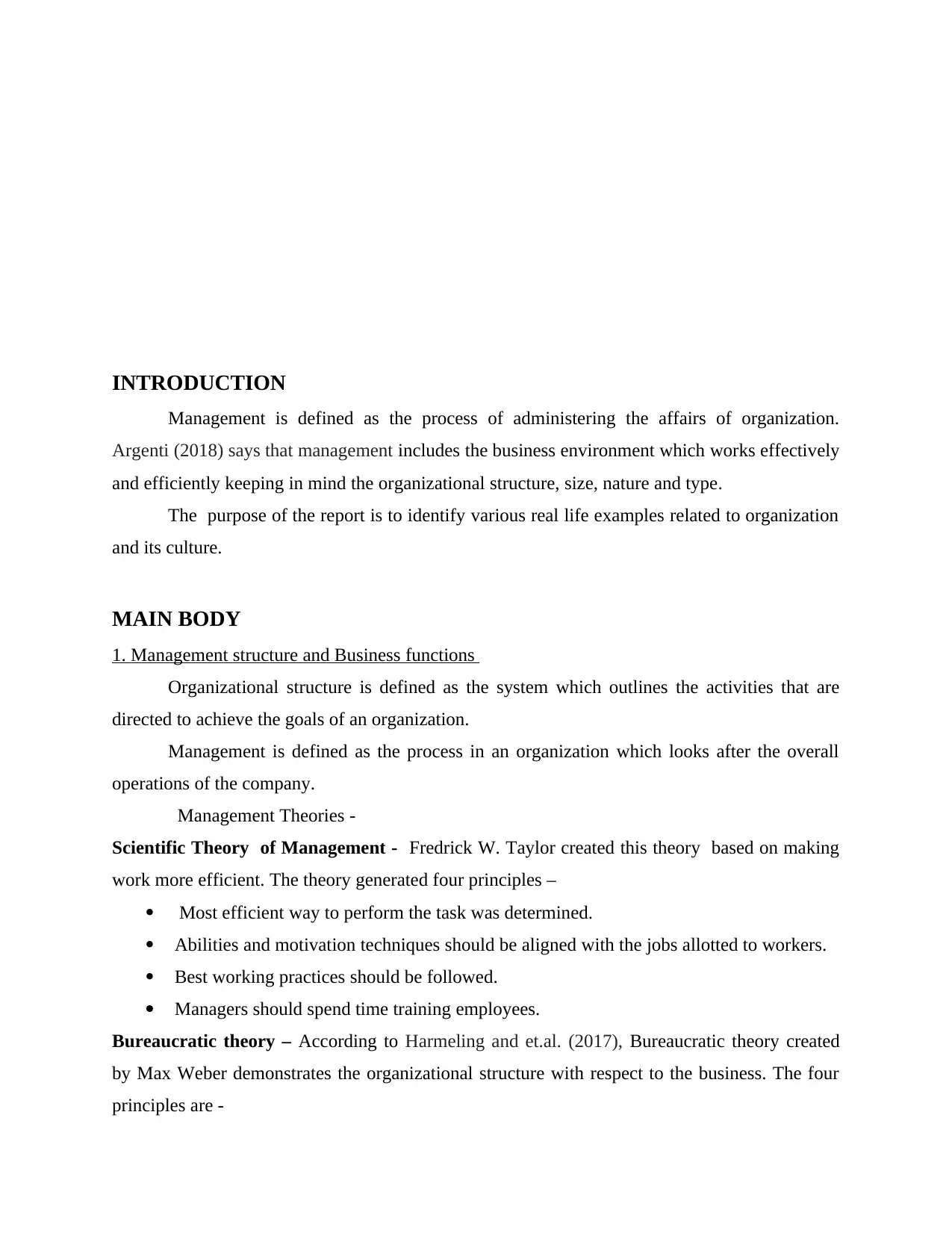
INTRODUCTION
Management is defined as the process of administering the affairs of organization.
Argenti (2018) says that management includes the business environment which works effectively
and efficiently keeping in mind the organizational structure, size, nature and type.
The purpose of the report is to identify various real life examples related to organization
and its culture.
MAIN BODY
1. Management structure and Business functions
Organizational structure is defined as the system which outlines the activities that are
directed to achieve the goals of an organization.
Management is defined as the process in an organization which looks after the overall
operations of the company.
Management Theories -
Scientific Theory of Management - Fredrick W. Taylor created this theory based on making
work more efficient. The theory generated four principles –
Most efficient way to perform the task was determined.
Abilities and motivation techniques should be aligned with the jobs allotted to workers.
Best working practices should be followed.
Managers should spend time training employees.
Bureaucratic theory – According to Harmeling and et.al. (2017), Bureaucratic theory created
by Max Weber demonstrates the organizational structure with respect to the business. The four
principles are -
Management is defined as the process of administering the affairs of organization.
Argenti (2018) says that management includes the business environment which works effectively
and efficiently keeping in mind the organizational structure, size, nature and type.
The purpose of the report is to identify various real life examples related to organization
and its culture.
MAIN BODY
1. Management structure and Business functions
Organizational structure is defined as the system which outlines the activities that are
directed to achieve the goals of an organization.
Management is defined as the process in an organization which looks after the overall
operations of the company.
Management Theories -
Scientific Theory of Management - Fredrick W. Taylor created this theory based on making
work more efficient. The theory generated four principles –
Most efficient way to perform the task was determined.
Abilities and motivation techniques should be aligned with the jobs allotted to workers.
Best working practices should be followed.
Managers should spend time training employees.
Bureaucratic theory – According to Harmeling and et.al. (2017), Bureaucratic theory created
by Max Weber demonstrates the organizational structure with respect to the business. The four
principles are -
⊘ This is a preview!⊘
Do you want full access?
Subscribe today to unlock all pages.

Trusted by 1+ million students worldwide
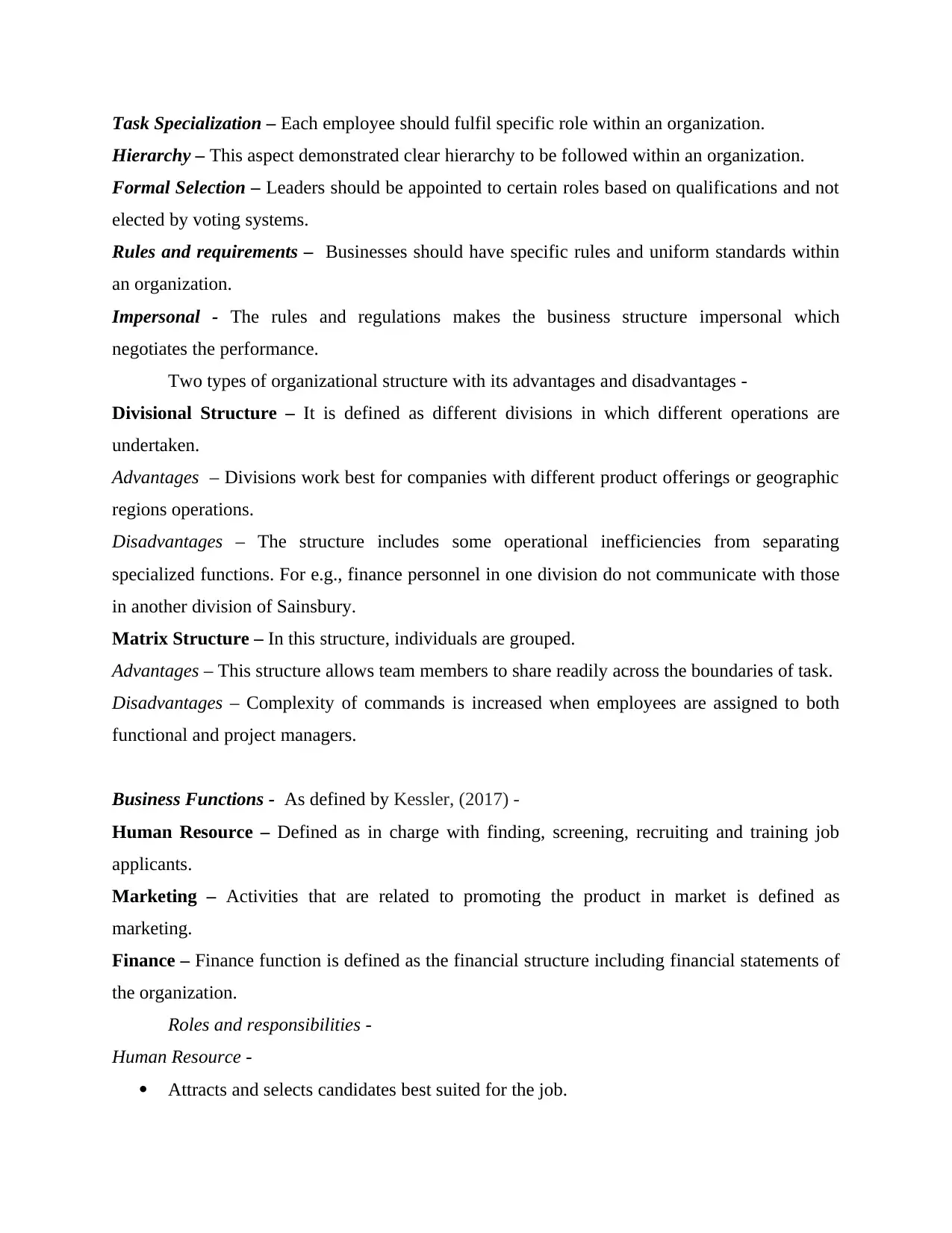
Task Specialization – Each employee should fulfil specific role within an organization.
Hierarchy – This aspect demonstrated clear hierarchy to be followed within an organization.
Formal Selection – Leaders should be appointed to certain roles based on qualifications and not
elected by voting systems.
Rules and requirements – Businesses should have specific rules and uniform standards within
an organization.
Impersonal - The rules and regulations makes the business structure impersonal which
negotiates the performance.
Two types of organizational structure with its advantages and disadvantages -
Divisional Structure – It is defined as different divisions in which different operations are
undertaken.
Advantages – Divisions work best for companies with different product offerings or geographic
regions operations.
Disadvantages – The structure includes some operational inefficiencies from separating
specialized functions. For e.g., finance personnel in one division do not communicate with those
in another division of Sainsbury.
Matrix Structure – In this structure, individuals are grouped.
Advantages – This structure allows team members to share readily across the boundaries of task.
Disadvantages – Complexity of commands is increased when employees are assigned to both
functional and project managers.
Business Functions - As defined by Kessler, (2017) -
Human Resource – Defined as in charge with finding, screening, recruiting and training job
applicants.
Marketing – Activities that are related to promoting the product in market is defined as
marketing.
Finance – Finance function is defined as the financial structure including financial statements of
the organization.
Roles and responsibilities -
Human Resource -
Attracts and selects candidates best suited for the job.
Hierarchy – This aspect demonstrated clear hierarchy to be followed within an organization.
Formal Selection – Leaders should be appointed to certain roles based on qualifications and not
elected by voting systems.
Rules and requirements – Businesses should have specific rules and uniform standards within
an organization.
Impersonal - The rules and regulations makes the business structure impersonal which
negotiates the performance.
Two types of organizational structure with its advantages and disadvantages -
Divisional Structure – It is defined as different divisions in which different operations are
undertaken.
Advantages – Divisions work best for companies with different product offerings or geographic
regions operations.
Disadvantages – The structure includes some operational inefficiencies from separating
specialized functions. For e.g., finance personnel in one division do not communicate with those
in another division of Sainsbury.
Matrix Structure – In this structure, individuals are grouped.
Advantages – This structure allows team members to share readily across the boundaries of task.
Disadvantages – Complexity of commands is increased when employees are assigned to both
functional and project managers.
Business Functions - As defined by Kessler, (2017) -
Human Resource – Defined as in charge with finding, screening, recruiting and training job
applicants.
Marketing – Activities that are related to promoting the product in market is defined as
marketing.
Finance – Finance function is defined as the financial structure including financial statements of
the organization.
Roles and responsibilities -
Human Resource -
Attracts and selects candidates best suited for the job.
Paraphrase This Document
Need a fresh take? Get an instant paraphrase of this document with our AI Paraphraser
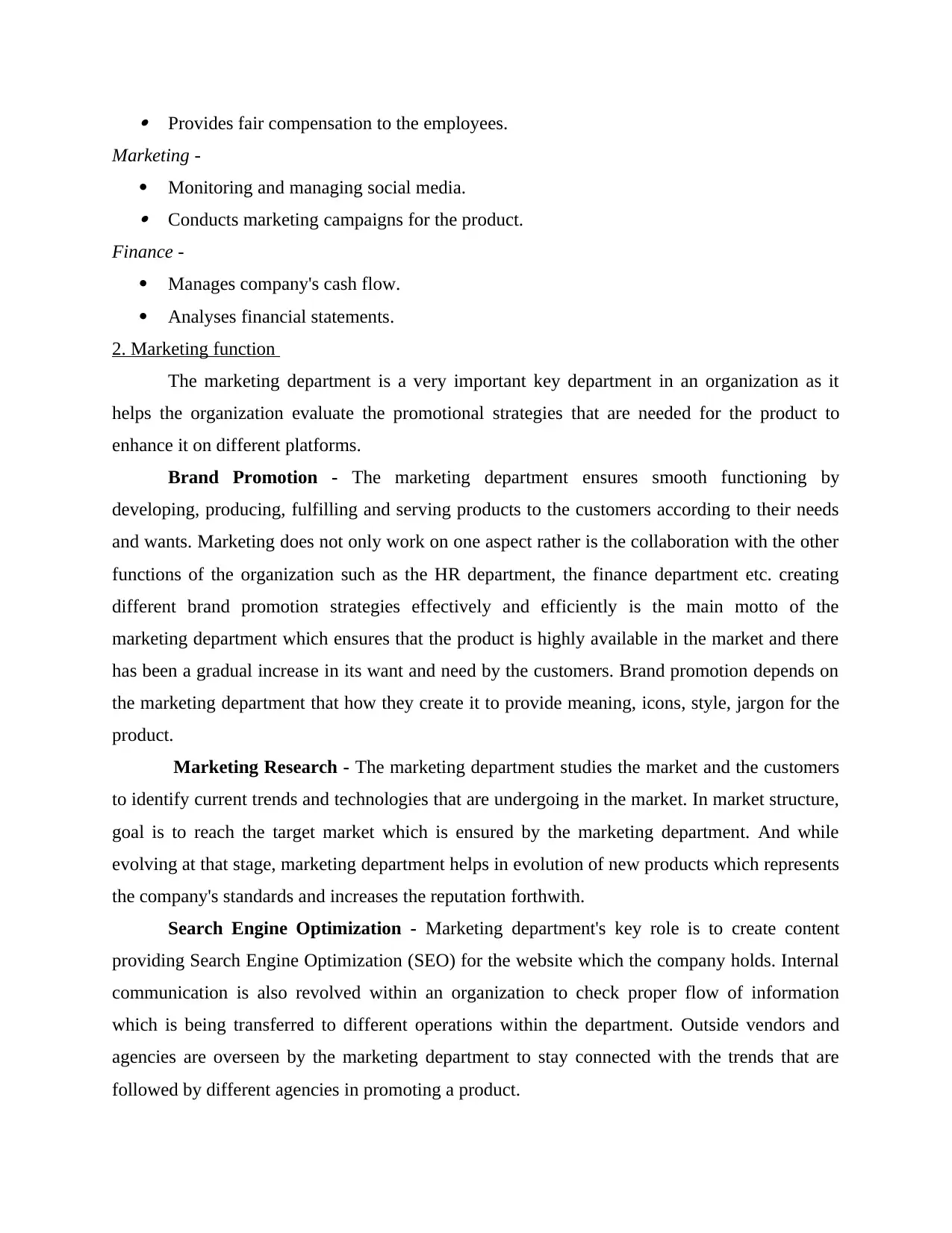
Provides fair compensation to the employees.
Marketing -
Monitoring and managing social media. Conducts marketing campaigns for the product.
Finance -
Manages company's cash flow.
Analyses financial statements.
2. Marketing function
The marketing department is a very important key department in an organization as it
helps the organization evaluate the promotional strategies that are needed for the product to
enhance it on different platforms.
Brand Promotion - The marketing department ensures smooth functioning by
developing, producing, fulfilling and serving products to the customers according to their needs
and wants. Marketing does not only work on one aspect rather is the collaboration with the other
functions of the organization such as the HR department, the finance department etc. creating
different brand promotion strategies effectively and efficiently is the main motto of the
marketing department which ensures that the product is highly available in the market and there
has been a gradual increase in its want and need by the customers. Brand promotion depends on
the marketing department that how they create it to provide meaning, icons, style, jargon for the
product.
Marketing Research - The marketing department studies the market and the customers
to identify current trends and technologies that are undergoing in the market. In market structure,
goal is to reach the target market which is ensured by the marketing department. And while
evolving at that stage, marketing department helps in evolution of new products which represents
the company's standards and increases the reputation forthwith.
Search Engine Optimization - Marketing department's key role is to create content
providing Search Engine Optimization (SEO) for the website which the company holds. Internal
communication is also revolved within an organization to check proper flow of information
which is being transferred to different operations within the department. Outside vendors and
agencies are overseen by the marketing department to stay connected with the trends that are
followed by different agencies in promoting a product.
Marketing -
Monitoring and managing social media. Conducts marketing campaigns for the product.
Finance -
Manages company's cash flow.
Analyses financial statements.
2. Marketing function
The marketing department is a very important key department in an organization as it
helps the organization evaluate the promotional strategies that are needed for the product to
enhance it on different platforms.
Brand Promotion - The marketing department ensures smooth functioning by
developing, producing, fulfilling and serving products to the customers according to their needs
and wants. Marketing does not only work on one aspect rather is the collaboration with the other
functions of the organization such as the HR department, the finance department etc. creating
different brand promotion strategies effectively and efficiently is the main motto of the
marketing department which ensures that the product is highly available in the market and there
has been a gradual increase in its want and need by the customers. Brand promotion depends on
the marketing department that how they create it to provide meaning, icons, style, jargon for the
product.
Marketing Research - The marketing department studies the market and the customers
to identify current trends and technologies that are undergoing in the market. In market structure,
goal is to reach the target market which is ensured by the marketing department. And while
evolving at that stage, marketing department helps in evolution of new products which represents
the company's standards and increases the reputation forthwith.
Search Engine Optimization - Marketing department's key role is to create content
providing Search Engine Optimization (SEO) for the website which the company holds. Internal
communication is also revolved within an organization to check proper flow of information
which is being transferred to different operations within the department. Outside vendors and
agencies are overseen by the marketing department to stay connected with the trends that are
followed by different agencies in promoting a product.
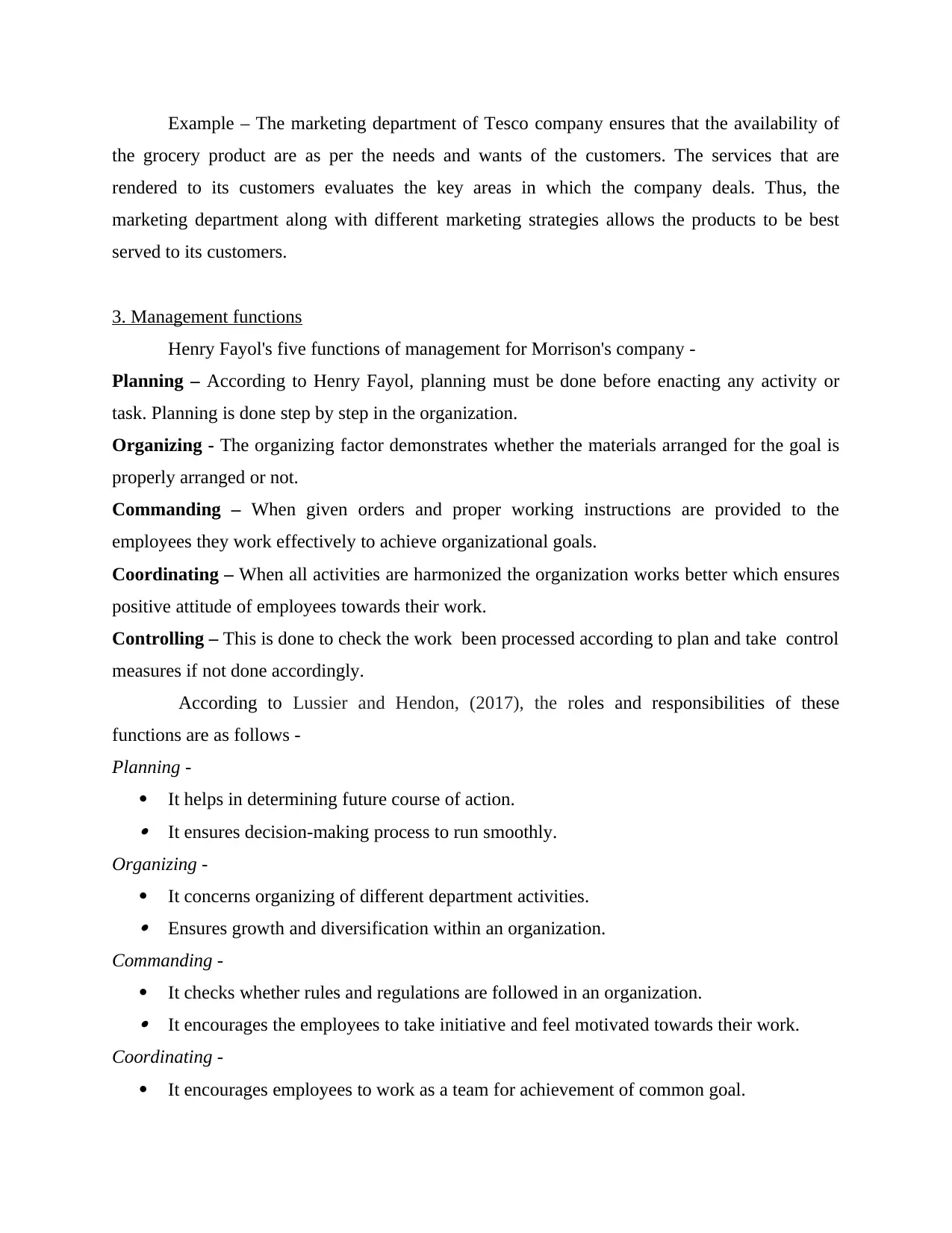
Example – The marketing department of Tesco company ensures that the availability of
the grocery product are as per the needs and wants of the customers. The services that are
rendered to its customers evaluates the key areas in which the company deals. Thus, the
marketing department along with different marketing strategies allows the products to be best
served to its customers.
3. Management functions
Henry Fayol's five functions of management for Morrison's company -
Planning – According to Henry Fayol, planning must be done before enacting any activity or
task. Planning is done step by step in the organization.
Organizing - The organizing factor demonstrates whether the materials arranged for the goal is
properly arranged or not.
Commanding – When given orders and proper working instructions are provided to the
employees they work effectively to achieve organizational goals.
Coordinating – When all activities are harmonized the organization works better which ensures
positive attitude of employees towards their work.
Controlling – This is done to check the work been processed according to plan and take control
measures if not done accordingly.
According to Lussier and Hendon, (2017), the roles and responsibilities of these
functions are as follows -
Planning -
It helps in determining future course of action. It ensures decision-making process to run smoothly.
Organizing -
It concerns organizing of different department activities. Ensures growth and diversification within an organization.
Commanding -
It checks whether rules and regulations are followed in an organization. It encourages the employees to take initiative and feel motivated towards their work.
Coordinating -
It encourages employees to work as a team for achievement of common goal.
the grocery product are as per the needs and wants of the customers. The services that are
rendered to its customers evaluates the key areas in which the company deals. Thus, the
marketing department along with different marketing strategies allows the products to be best
served to its customers.
3. Management functions
Henry Fayol's five functions of management for Morrison's company -
Planning – According to Henry Fayol, planning must be done before enacting any activity or
task. Planning is done step by step in the organization.
Organizing - The organizing factor demonstrates whether the materials arranged for the goal is
properly arranged or not.
Commanding – When given orders and proper working instructions are provided to the
employees they work effectively to achieve organizational goals.
Coordinating – When all activities are harmonized the organization works better which ensures
positive attitude of employees towards their work.
Controlling – This is done to check the work been processed according to plan and take control
measures if not done accordingly.
According to Lussier and Hendon, (2017), the roles and responsibilities of these
functions are as follows -
Planning -
It helps in determining future course of action. It ensures decision-making process to run smoothly.
Organizing -
It concerns organizing of different department activities. Ensures growth and diversification within an organization.
Commanding -
It checks whether rules and regulations are followed in an organization. It encourages the employees to take initiative and feel motivated towards their work.
Coordinating -
It encourages employees to work as a team for achievement of common goal.
⊘ This is a preview!⊘
Do you want full access?
Subscribe today to unlock all pages.

Trusted by 1+ million students worldwide
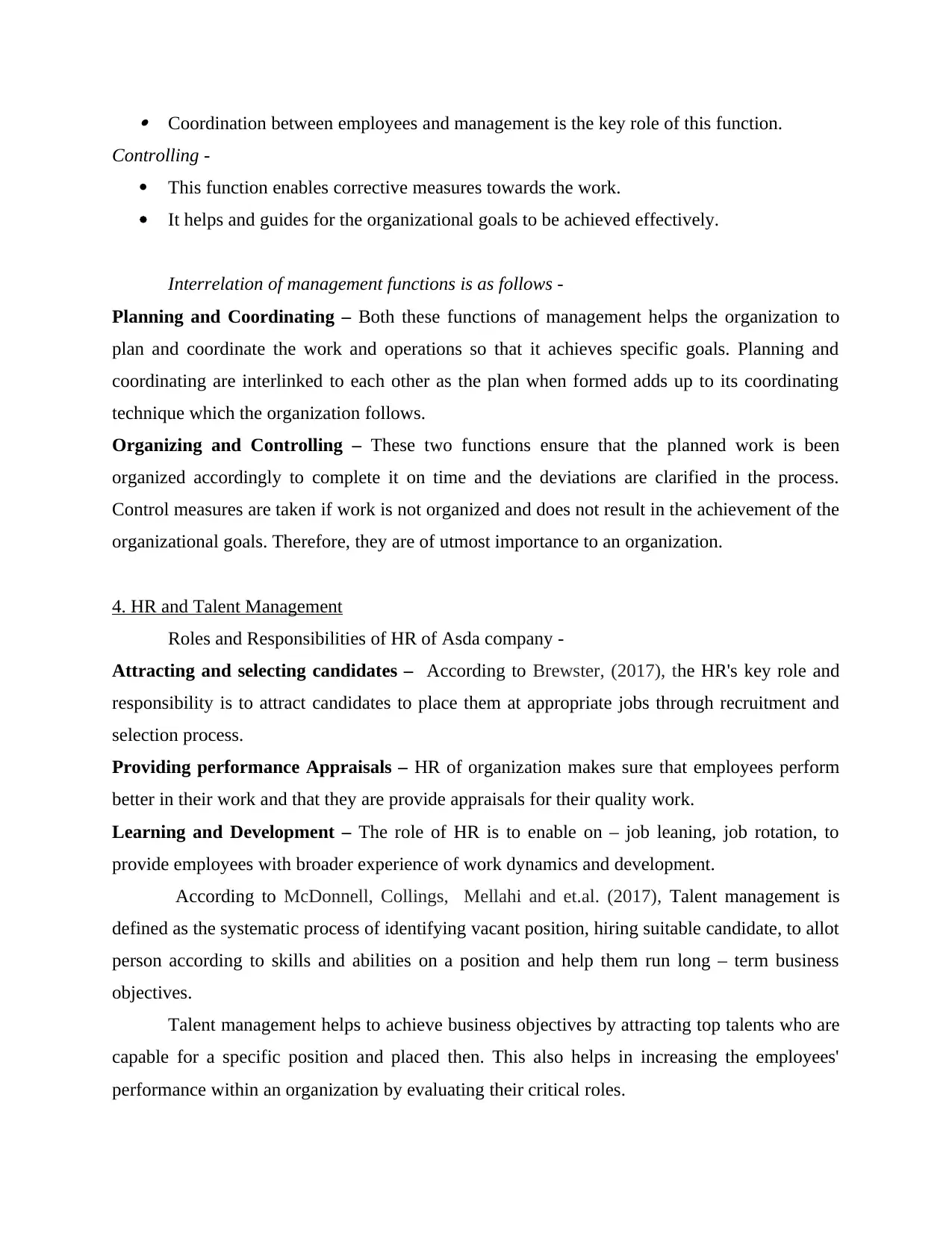
Coordination between employees and management is the key role of this function.
Controlling -
This function enables corrective measures towards the work.
It helps and guides for the organizational goals to be achieved effectively.
Interrelation of management functions is as follows -
Planning and Coordinating – Both these functions of management helps the organization to
plan and coordinate the work and operations so that it achieves specific goals. Planning and
coordinating are interlinked to each other as the plan when formed adds up to its coordinating
technique which the organization follows.
Organizing and Controlling – These two functions ensure that the planned work is been
organized accordingly to complete it on time and the deviations are clarified in the process.
Control measures are taken if work is not organized and does not result in the achievement of the
organizational goals. Therefore, they are of utmost importance to an organization.
4. HR and Talent Management
Roles and Responsibilities of HR of Asda company -
Attracting and selecting candidates – According to Brewster, (2017), the HR's key role and
responsibility is to attract candidates to place them at appropriate jobs through recruitment and
selection process.
Providing performance Appraisals – HR of organization makes sure that employees perform
better in their work and that they are provide appraisals for their quality work.
Learning and Development – The role of HR is to enable on – job leaning, job rotation, to
provide employees with broader experience of work dynamics and development.
According to McDonnell, Collings, Mellahi and et.al. (2017), Talent management is
defined as the systematic process of identifying vacant position, hiring suitable candidate, to allot
person according to skills and abilities on a position and help them run long – term business
objectives.
Talent management helps to achieve business objectives by attracting top talents who are
capable for a specific position and placed then. This also helps in increasing the employees'
performance within an organization by evaluating their critical roles.
Controlling -
This function enables corrective measures towards the work.
It helps and guides for the organizational goals to be achieved effectively.
Interrelation of management functions is as follows -
Planning and Coordinating – Both these functions of management helps the organization to
plan and coordinate the work and operations so that it achieves specific goals. Planning and
coordinating are interlinked to each other as the plan when formed adds up to its coordinating
technique which the organization follows.
Organizing and Controlling – These two functions ensure that the planned work is been
organized accordingly to complete it on time and the deviations are clarified in the process.
Control measures are taken if work is not organized and does not result in the achievement of the
organizational goals. Therefore, they are of utmost importance to an organization.
4. HR and Talent Management
Roles and Responsibilities of HR of Asda company -
Attracting and selecting candidates – According to Brewster, (2017), the HR's key role and
responsibility is to attract candidates to place them at appropriate jobs through recruitment and
selection process.
Providing performance Appraisals – HR of organization makes sure that employees perform
better in their work and that they are provide appraisals for their quality work.
Learning and Development – The role of HR is to enable on – job leaning, job rotation, to
provide employees with broader experience of work dynamics and development.
According to McDonnell, Collings, Mellahi and et.al. (2017), Talent management is
defined as the systematic process of identifying vacant position, hiring suitable candidate, to allot
person according to skills and abilities on a position and help them run long – term business
objectives.
Talent management helps to achieve business objectives by attracting top talents who are
capable for a specific position and placed then. This also helps in increasing the employees'
performance within an organization by evaluating their critical roles.
Paraphrase This Document
Need a fresh take? Get an instant paraphrase of this document with our AI Paraphraser
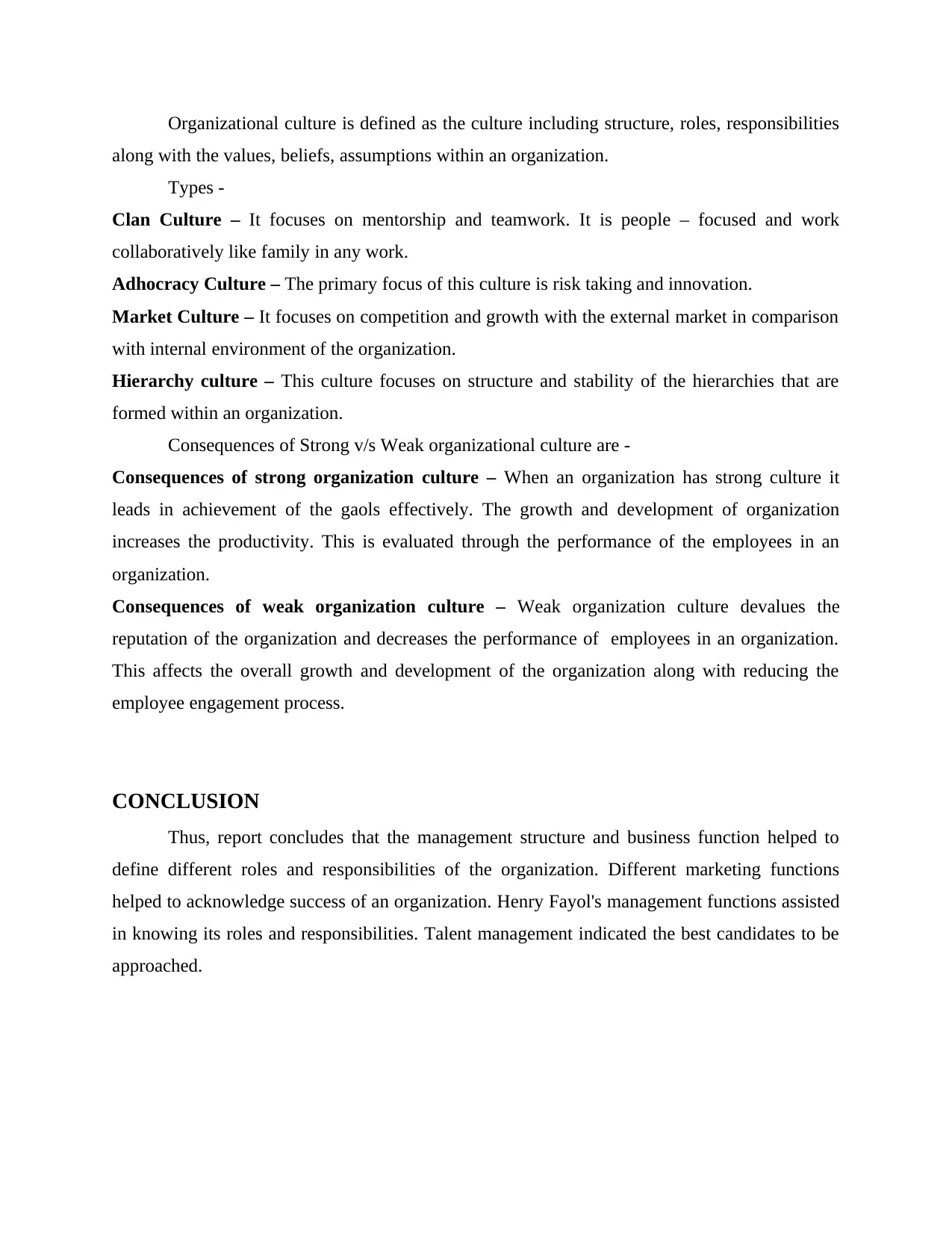
Organizational culture is defined as the culture including structure, roles, responsibilities
along with the values, beliefs, assumptions within an organization.
Types -
Clan Culture – It focuses on mentorship and teamwork. It is people – focused and work
collaboratively like family in any work.
Adhocracy Culture – The primary focus of this culture is risk taking and innovation.
Market Culture – It focuses on competition and growth with the external market in comparison
with internal environment of the organization.
Hierarchy culture – This culture focuses on structure and stability of the hierarchies that are
formed within an organization.
Consequences of Strong v/s Weak organizational culture are -
Consequences of strong organization culture – When an organization has strong culture it
leads in achievement of the gaols effectively. The growth and development of organization
increases the productivity. This is evaluated through the performance of the employees in an
organization.
Consequences of weak organization culture – Weak organization culture devalues the
reputation of the organization and decreases the performance of employees in an organization.
This affects the overall growth and development of the organization along with reducing the
employee engagement process.
CONCLUSION
Thus, report concludes that the management structure and business function helped to
define different roles and responsibilities of the organization. Different marketing functions
helped to acknowledge success of an organization. Henry Fayol's management functions assisted
in knowing its roles and responsibilities. Talent management indicated the best candidates to be
approached.
along with the values, beliefs, assumptions within an organization.
Types -
Clan Culture – It focuses on mentorship and teamwork. It is people – focused and work
collaboratively like family in any work.
Adhocracy Culture – The primary focus of this culture is risk taking and innovation.
Market Culture – It focuses on competition and growth with the external market in comparison
with internal environment of the organization.
Hierarchy culture – This culture focuses on structure and stability of the hierarchies that are
formed within an organization.
Consequences of Strong v/s Weak organizational culture are -
Consequences of strong organization culture – When an organization has strong culture it
leads in achievement of the gaols effectively. The growth and development of organization
increases the productivity. This is evaluated through the performance of the employees in an
organization.
Consequences of weak organization culture – Weak organization culture devalues the
reputation of the organization and decreases the performance of employees in an organization.
This affects the overall growth and development of the organization along with reducing the
employee engagement process.
CONCLUSION
Thus, report concludes that the management structure and business function helped to
define different roles and responsibilities of the organization. Different marketing functions
helped to acknowledge success of an organization. Henry Fayol's management functions assisted
in knowing its roles and responsibilities. Talent management indicated the best candidates to be
approached.
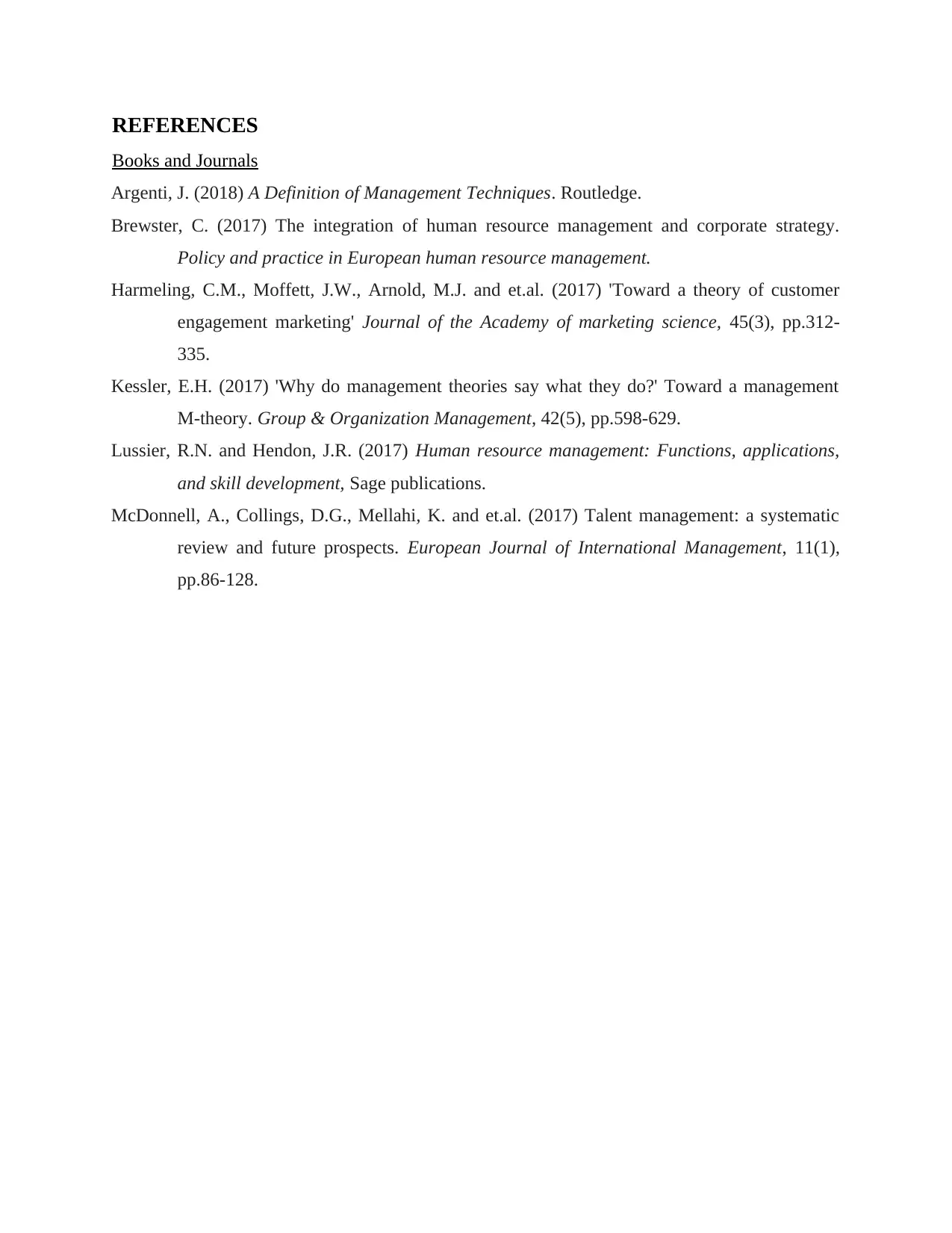
REFERENCES
Books and Journals
Argenti, J. (2018) A Definition of Management Techniques. Routledge.
Brewster, C. (2017) The integration of human resource management and corporate strategy.
Policy and practice in European human resource management.
Harmeling, C.M., Moffett, J.W., Arnold, M.J. and et.al. (2017) 'Toward a theory of customer
engagement marketing' Journal of the Academy of marketing science, 45(3), pp.312-
335.
Kessler, E.H. (2017) 'Why do management theories say what they do?' Toward a management
M-theory. Group & Organization Management, 42(5), pp.598-629.
Lussier, R.N. and Hendon, J.R. (2017) Human resource management: Functions, applications,
and skill development, Sage publications.
McDonnell, A., Collings, D.G., Mellahi, K. and et.al. (2017) Talent management: a systematic
review and future prospects. European Journal of International Management, 11(1),
pp.86-128.
Books and Journals
Argenti, J. (2018) A Definition of Management Techniques. Routledge.
Brewster, C. (2017) The integration of human resource management and corporate strategy.
Policy and practice in European human resource management.
Harmeling, C.M., Moffett, J.W., Arnold, M.J. and et.al. (2017) 'Toward a theory of customer
engagement marketing' Journal of the Academy of marketing science, 45(3), pp.312-
335.
Kessler, E.H. (2017) 'Why do management theories say what they do?' Toward a management
M-theory. Group & Organization Management, 42(5), pp.598-629.
Lussier, R.N. and Hendon, J.R. (2017) Human resource management: Functions, applications,
and skill development, Sage publications.
McDonnell, A., Collings, D.G., Mellahi, K. and et.al. (2017) Talent management: a systematic
review and future prospects. European Journal of International Management, 11(1),
pp.86-128.
⊘ This is a preview!⊘
Do you want full access?
Subscribe today to unlock all pages.

Trusted by 1+ million students worldwide
1 out of 9
Related Documents
Your All-in-One AI-Powered Toolkit for Academic Success.
+13062052269
info@desklib.com
Available 24*7 on WhatsApp / Email
![[object Object]](/_next/static/media/star-bottom.7253800d.svg)
Unlock your academic potential
Copyright © 2020–2025 A2Z Services. All Rights Reserved. Developed and managed by ZUCOL.




